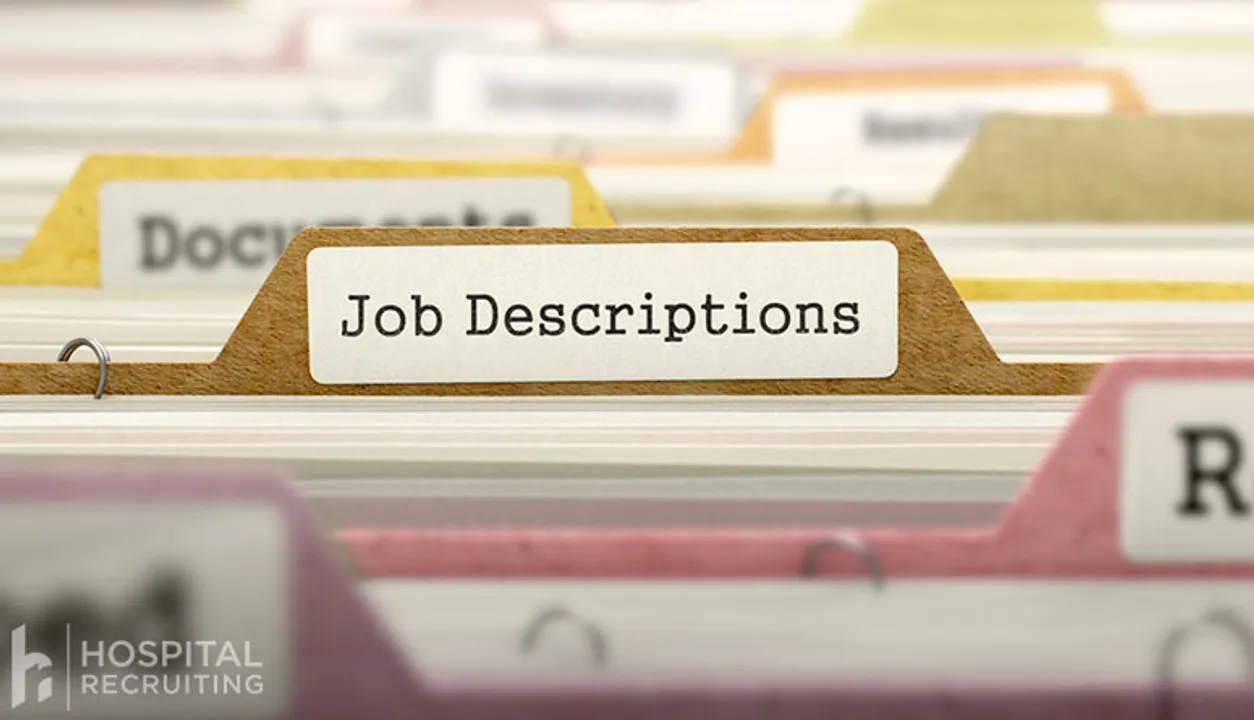Job descriptions: Updating for Success in Today’s Market

As institutions look to hire in the face of unprecedented competition and talent shortages, the last place they may be looking is at their job descriptions, but it might be the first line of attack. Your job descriptions are blueprints for every aspect of the hiring and employment process. They determine what skills, qualifications and certifications are required for the position, they guide what’s posted when looking for a candidate, and they help interviewers stay on track to discuss the most salient topics for the job. A dated job description mires the process from beginning to end, making it harder to recruit and hire the right candidate.
In today’s difficult talent market, healthcare facilities are looking to shift their job description templates from laundry lists of ‘must-haves’ to descriptions that inspire and invite candidates to apply. When market conditions are good, a good job description will help you hire; when conditions are bad, a bad job description will make it worse. Here are some tips on how and when you should be reviewing job descriptions in your institution.
When to update Job Descriptions
The most forward-thinking institutions review and update their job descriptions annually, adapting the language to any changes to the position or its requirements. A great reminder for annual review is during performance evaluations. Managers should be looking to the job description to inform their ratings of staffers during reviews. Does the employee meet the minimum requirements the JD outlines: do they go beyond or lag behind? This baseline standard helps create fair evaluations, but only if the JD is current and accurate. Before you start writing evaluations, managers should review (and even ask staffers to review) the JD to assure it reflects the most current duties of the position.
If you’re not routinely looking through and revising JDs, it’s important to do so at least before hiring for a new position. Before you post that job online, make sure the information is accurate and current; otherwise, you’ll be making an ill-informed hiring decision that could result in, at best, a waste of time for you and the candidate; at worst, a bad hire.
What to update
The first thing hiring managers and HR professionals should revise on their job descriptions are the duties and responsibilities. Are they a reflection of the current needs and tasks that the position holds? If not, make sure to update them.
Next, look at qualifications. You may not be able to waive licensing and certification requirements, but are your years’ experience minimums reasonable in today’s market? For many institutions, ‘minimum 3 to 5 years experience’ has become boilerplate on job descriptions, often to their detriment. Are 2 to 3 years or even 1 to 2 years acceptable? You may be opening your facility to a much larger talent pool with a simple discussion and revision of this single qualification.
Another area that might warrant consideration is ‘exact experience’ that’s often carried over from revision after revision of a job description with little actual need. If you’re limiting the amount of talent responding to your position with this requirement, ask if it’s really necessary or simply a holdover from a time when applicants were plentiful.
Look at the wording and tone of the JD itself. Does it read like a laundry list of demands, or a description of working in a rewarding, welcoming environment that prizes achievement? Many facilities post their job descriptions online; some send a copy for review to candidates scheduled for an interview. What does yours say about your facility? Does it say you hire top talent with a need to serve the community in the best institution in the area? Or does it say you’re looking for automatons who will perform rote tasks until they retire?
The challenge isn’t to eliminate tasks, it’s to translate them into appealing duties that underscore the commitment of the job seeker. Yes, you’re attending to the needs of patients, but as you list that duty, make sure to include that you’re attending to their needs, striving to meet the highest of standards of patient care. Does your description emphasize decision-making, if appropriate? Make sure to highlight autonomy in the role, if applicable. Read through your job descriptions as though you were a candidate. Does it appeal to your commitment to patient care? Does the institution value and leverage your experience and qualifications? Does the role seem rewarding and challenging? These are the things a job seeker is looking for – particularly if they’re currently employed. If you’re simply listing duties applicants already perform, there’s little reason for them to make a change. Create a job description that speaks to their goals and aspirations to capture top talent.
The mission-driven job description
All job descriptions should promote your facility outright and in subtle ways. A focus on your mission (with your statement included in the JD) should underscore the way the institution strives for achievement. If your mission is the most patient-centric experience possible, stress this touchpoint as much as possible. If community service drives your facility, include outreach efforts and opportunities for volunteerism. Reinforce what the institution values – you’ll find job seekers with similar values vying for your attention and an interview.
Accentuate how your facility will help candidates grow and develop. Do you offer continuing education through your institution or outside sources? If there is a career trajectory built into roles, include the steps employees should take to start and keep upward mobility. You could include phrases like ‘leverages educational resources to advance skills and competencies’ or ‘works with supervisor to assure training and development provides a path to promotion.’ These duties, baked into the job description, remind potential hires (and current employees) they have the support of the institution when it comes to their professional growth.
Today’s tight talent market shows no signs of loosening any time soon. Building stronger, more candidate-focused job descriptions could be the first step to recruiting and hiring top tier candidates, no matter what the market holds.
Related Posts
